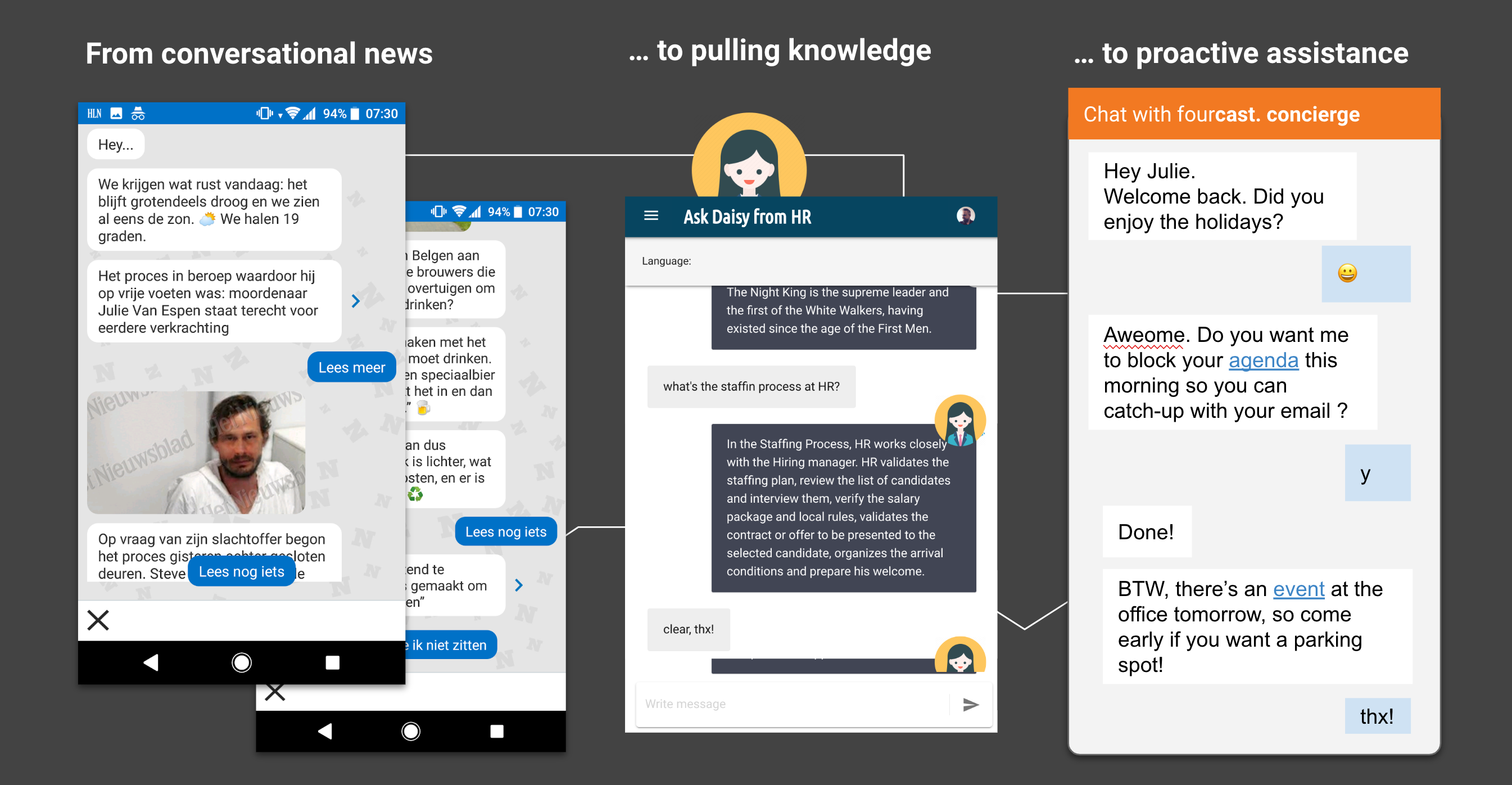Is your organisation struggling with internal communications? You’re not alone. A lot of companies have a hard time defining their internal comms strategy and related to that, their communications tools like their intranet. Last month, we organised an event “Rethink your internal communications” around this hot topic. Let me share the most important takeaways with you in this series of blog posts. It all begins with your internal communications strategy. In this first post, you’ll discover the 5 intranet trends you need to take into account when redefining your IC strategy.
The Rethink your internal communications event we organised at Google Digital Atelier in Brussels on the 7th of June 2019 consisted of several parts. I’ll share the main points of the different topics with you in this blog post series.
Today, let’s dive into part 1: How to shape your internal communications strategy by using 5 intranet trends?

How to reshape your internal communications strategy?
First up for reflection: your internal comms strategy design. Do you even have an internal communications (abbreviated as ‘IC’) strategy? Armin Fabritius, Internal Comms expert & Chief Inspirational Officer at Fourcast, starts the session (which he calls ‘adventures in IC strategy design’) with some interesting questions to the audience. Such as: what is your most important IC channel? Which roles does your current intranet play?

Immediate food for thought at the beginning of the event, but also for you at the start of this blog post, because the two of them are often closely related.
Starting point for rethinking your internal comms strategy nowadays should be some important intranet trends that will shape your future intranet. Let’s take a closer look at 5 of these trends and at how your new intranet can benefit from them.
Intranet Trend #1: Digital Workplace
Intranets are not just about (corporate) communications anymore. They can become the cornerstone of an upcoming trend of the last years called the ‘digital workplace’. And the thought of becoming a digital workplace is increasingly attractive to companies, as they realise the advantages of implementing an array of digital tools like Google’s G Suite for their workforce to collaborate and communicate more and better. Amongst others, these benefits include a higher engagement of employees, more collaboration, higher productivity and easier compliance with processes.
When integrated, and with your intranet acting as a gateway to these digital tools of the digital workplace, your company can unlock numerous advantages.

Intranet Trend #2: Artificial Intelligence for Internal Communications
Big data, artificial intelligence and smart assistants are three examples of buzzwords referring to cutting edge technologies that appear everywhere these days. So, should you think about using them in your internal communications strategy?
You might want to think: yay! More tech! Tech is good! AI is cool!
But the truth is that you need a better reason to want to consider using these. There’s only one that will move things from just experimenting with AI to embedding it in your company’s DNA, according to Armin. And that one reason is: you want to become a people-first company.
What does that have to do with high tech stuff like AI, NL, big data and other buzzwords?
Becoming a people-first company
Let’s take a closer look at what it means to be a people-first company. First of all, employees are the most valuable resources in your company. Second, employees are people too. And third, you aim to be relevant to each and every single employee.
So as an employer, you want to know your employees really. Just as you probably consider your customer’s goals, emotions, context, interests, behaviour, needs, people connections and brand connections; you should consider the same to get to know each and every one of your employees. And you probably already possess a lot of these data, neatly tied in data silos across the company: data on emails, meetings, events, performance, CV, health, GPS, analytics etc.

Personalise communications
It’s in the integration and activation of all this employee data in a hyper personalised approach that the technology can help. AI is for example able to integrate your data across silos, extract insights from the big data you have on your employees and then to push personalised content to all employees through your intranet.
In terms of data activation you can think about chatbots, for example, that employees can use to pull knowledge about HR processes in your company. Or even one step further, a chatbot that offers proactive assistance to employees.

Intranet Trend #3: Data Privacy
With new, more complex privacy legislations put in place in Europe; plus a growing consciousness about data privacy, this is certainly something to consider in your internal comms strategy and intranet setup.
Only a few things to think about concerning data privacy are:
- How and where do you store the personal data of your employees, sometimes including sensitive data like data about salaries and health?
- Who are the data processors and controllers of your employee data?
- How do you inform and ask the consent of your employees for the way you manage their data? Will you ask to sign contracts, accept cookies, or work with disclaimers?
- How do you handle data subject rights: view/access rights, delete personally identifiable data on request, etc?
Intranet Trend #4: Actions & Micro Integrations
The days that the main task for an intranet was simply to provide top-down content to employees are definitely gone. With technology getting more and more advanced, the focus shifted from only offering content to more and more ‘getting things done’ through action & process oriented intranets.
This type of intranet focuses on micro-integrations of other tools and apps that are used within the organisation, for example the office suite that is accessible from the intranet and documents that can be easily found through this way.
Integrations also are a huge help in boosting the adoption of your intranet, because it provides more value throughout the day than simply the corporate communications that are only there to read and not necessarily to interact with.
Intranet Trend #5: Social Advocacy
Let’s face some statistics: employees are twice as trusted as a CEO, senior executive or activist consumer (according to Edelman). Brand messages are also shared 24x more frequently when they are distributed by employees, compared to your official company accounts (according to MSL Group). Let’s take a job posting from your company as an example: when your company LinkedIn page shares a job opening, it will probably get less engagement than when it is shared by one of your employees.
That is what Social Advocacy is all about: it’s your employees spreading communications about your company to the outside world. As a company, you can use this social advocacy to get a higher reach for your communications, plus increase your credibility as a company.
That might concern you, as you don’t want all your internal comms spread out externally without having any control over it. The question for your internal comms strategy is then: how will you make it as easy and straightforward as possible for your employees to share company updates with their network, in the way you approve of?

How to bring it all together?
Imagine you can bring all of these trends and insights together in one new intranet, with one point of access, as a one-stop shop for your employees.
That’s where a social, collaborative intranet like LumApps comes into play. With the recent announcement of the social advocacy tool that is included in this intranet solution, all of the trends above are seamlessly integrated in one intranet.
But will this one, decent new intranet be all it takes to set your internal communications on the right track, for good? The answer is no: like with all technology, the implementation of it alone is not enough.
You will have to (re)build your internal communications strategy to operationalise in your new intranet.

To draft your strategy, you should include answers to these questions:
- Analyse your current strategy: what are your current pain points as well as strong points?
- What’s your vision?
- Which goals do you want to accomplish?
- What will be your metrics for success?
- How will you organise?
- What will be your communications channels?
- Which data will you gather, how will you manage, integrate and activate it?
Next Step: operationalise
Next step is the operationalisation of your new strategy, where you have three remaining important to do’s before you kickstart your new intranet. These are constructing your employee personas, creating your user stories and mapping your employee journey.
Stay tuned for the next blog post in this series that will get you started with those three topics.
In this article we took a look at how you can use 5 intranet trends of the last years to redefine your internal communications strategy and the role your new intranet will play in it. It’s the first step towards improved internal communications in your company.
